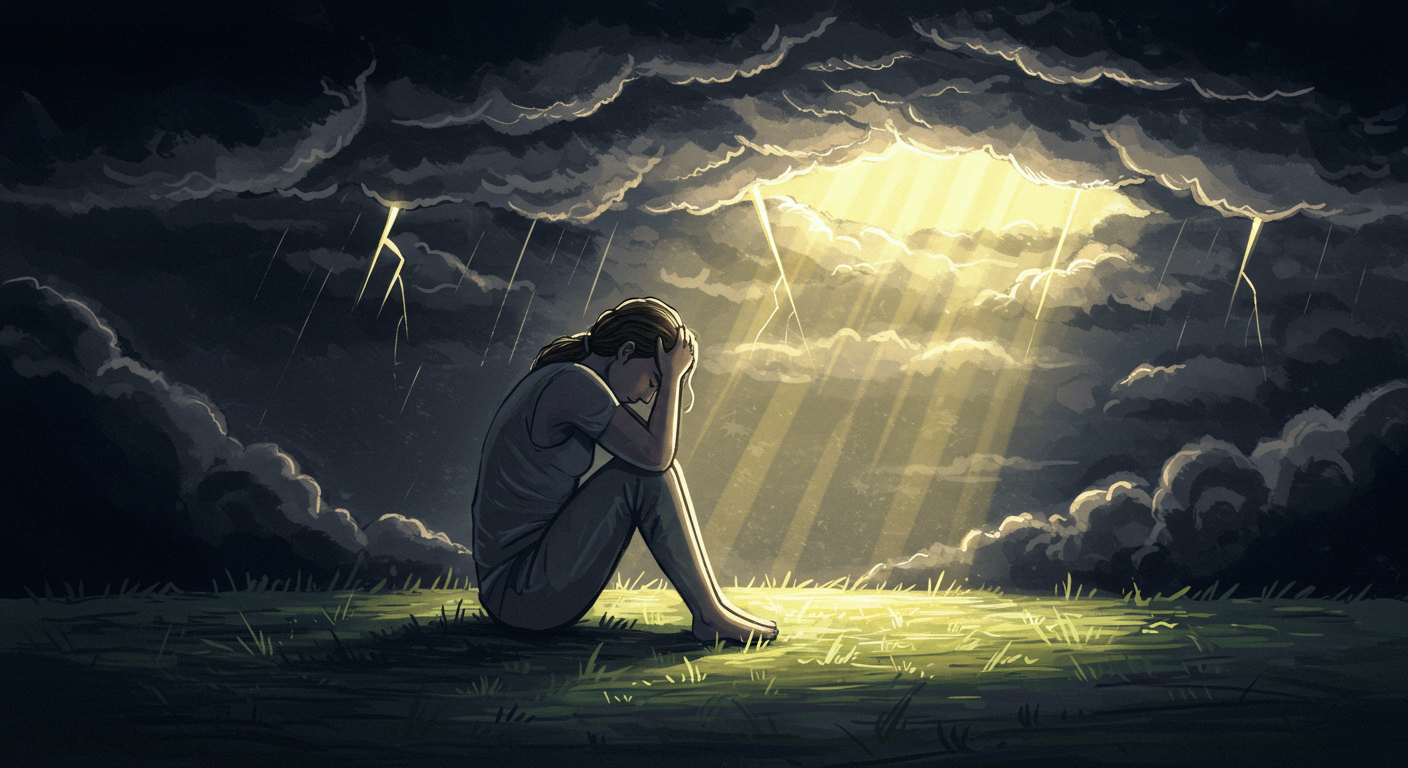Table of Contents
- What is Emotional Turmoil?
- Identifying Emotional Turmoil in a Sentence
- Emotional Turmoil Symptoms to Watch For
- Emotional Turmoil Examples from Everyday Life
- Causes of Emotional Turmoil
- Emotional Turmoil in Relationships
- The Impact of Emotional Turmoil on Mental Health
- Practical Steps to Overcome Emotional Turmoil
- Mindfulness Techniques for Inner Peace
- Building a Support System to Navigate Hard Times
- Frequently Asked Questions
What is Emotional Turmoil?
Emotional turmoil can be described as a state of inner conflict or distress where overwhelming feelings disrupt our mental and emotional stability.
It’s that gnawing sensation you get during periods of uncertainty, heartbreak, or stress, when your emotions spiral out of control.
This experience touches everyone at some point in life, whether due to personal setbacks, professional challenges, or unresolvable conflicts.
At its core, emotional turmoil is a chaotic mix of feelings like anxiety, anger, sadness, and confusion.
These feelings often occur simultaneously, creating inner unrest. For instance, think about how you feel when a loved one lets you down—you may feel hurt, betrayed, yet still love them.
This conflicting wave of emotions is the essence of turmoil, a feeling that requires resolution to find peace.
The good news is that emotional turmoil is not a permanent state.
By understanding it, analyzing its presence, and adopting effective strategies, you can restore balance to your life.
Identifying Emotional Turmoil in a Sentence
Sometimes, pinpointing emotional turmoil may feel difficult. Here’s how it looks when framed in a sentence:
- “After losing his job, John felt torn between frustration with himself and hope for new opportunities—a classic case of emotional turmoil.”
The key takeaway is that emotional turmoil involves contradictory emotions.
One part of you may desire to move forward, while another clings to past frustrations or negative experiences.
This clash is what creates the inner conflict recognized as emotional turmoil.
Understanding emotional turmoil in these terms allows us to identify it in everyday situations. For example:
- “Sarah struggled to decide whether to end her toxic friendship, highlighting emotional turmoil in relationships.”
- “Mark battled guilt and relief after relocating abroad, a universal example of emotional turmoil many experience.”
Learning to phrase emotional turmoil in this way helps us articulate what we’re feeling, an essential first step toward resolution.
Emotional Turmoil Symptoms to Watch For
Recognizing the symptoms of emotional turmoil can help you address it before it escalates.
Below are some key indicators:
- Mood Swings – One moment you’re hopeful, and the next you’re overwhelmed with sadness.
- Difficulty Focusing – Your mind drifts, unable to settle on one thought or responsibility.
- Troubled Sleep Patterns – Insomnia or oversleeping often accompany emotional imbalance.
- Physical Symptoms – Headaches, lethargy, or stomach aches frequently reflect inner emotional struggles.
- Irritability – Little things upset you more than usual, leaving you uneasy and agitated.
- Excessive Worry – You find yourself consumed by “what if” scenarios.
- Social Withdrawal – You avoid friends or family, feeling too emotionally drained to engage.
By identifying these symptoms early, you can take proactive steps to regain control over your emotions and steer your mental state towards calmness.
| Symptom | Description | Possible Impact |
|---|---|---|
| Lack of Sleep | Difficulty falling asleep or staying asleep, often linked to overthinking or stress. | Leads to fatigue, decreased focus, and impairment in daily activities. |
| Loss of Appetite | A noticeable decline in interest or enjoyment when eating. | Can result in weight loss, nutritional deficiencies, and weakened immunity. |
| Physical Pain | Manifestations such as headaches, muscle tension, or stomach aches often tied to underlying stress. | May affect work performance and overall quality of life. |
| Irritability | Heightened sensitivity to minor irritants, resulting in frequent agitation. | Can strain relationships and increase personal frustration. |
| Excessive Worry | Continuous dwelling on worst-case scenarios that creates mental distress. | Impedes decision-making and exacerbates stress levels. |
| Social Withdrawal | Avoidance of social interactions due to emotional exhaustion. | Contributes to feelings of loneliness and alienation from support networks. |
| Difficulty Concentrating | Struggling to focus on tasks due to preoccupation with intrusive thoughts. | Hinders productivity and ability to complete responsibilities effectively. |
| Lack of Motivation | Reduced interest or ambition in pursuing goals or daily tasks. | Can lead to missed opportunities and a sense of stagnation. |
This structured table provides a clear overview of common emotional or stress-related symptoms, their descriptions, and the potential consequences if left unaddressed.
|When these symptoms persist, seeking support from friends, family, or a mental health professional becomes vital.
Emotional Turmoil Examples from Everyday Life
Unexpected life challenges, such as a demanding workload, financial difficulties, or conflicts in relationships, can heavily contribute to emotional turmoil.
The inability to meet personal or professional expectations often leads to feelings of inadequacy and frustration.
Similarly, sudden changes like the loss of a loved one or a major relocation can evoke distress and uncertainty.
Everyday scenarios, like experiencing repeated failures or lack of support from close ones, may amplify feelings of isolation.
Over time, these emotional struggles can manifest in subtle ways, such as losing interest in activities that once brought joy or having difficulty making decisions.
Recognizing these signs early and addressing them proactively can prevent further emotional strain.
Recognizing emotional turmoil isn’t always straightforward, but these examples may help you spot it:
- Career Change Decisions – Facing a dream versus reality situation—secure job vs. uncertain new opportunity.
- Breakups – Feeling torn between letting go and holding onto cherished memories.
- Family Conflicts – Navigating the mix of guilt and love when disagreements arise.
- Moving To a New City – Feeling excited but terrified of starting fresh without familiar support.
- Parenting Challenges – Balancing strictness and compassion, coupled with self-doubt in decisions.
These instances remind us that emotional turmoil is part of life’s complexity.
Acknowledging this truth is one of the first steps to responding constructively.
Causes of Emotional Turmoil
Emotional turmoil often arises from various internal and external factors.
Internally, conflicts within oneself, such as battling insecurities or unresolved trauma, can leave a person feeling overwhelmed.
Externally, significant life changes like divorce, job loss, or the death of a loved one can act as triggering events.
The pressure of societal expectations, combined with the rapid pace of modern life, frequently adds to this emotional strain.
Additionally, unhealthy relationships or lack of a support system can intensify feelings of isolation and distress.
Understanding these causes is crucial in recognizing the underlying issues and working towards solutions that foster resilience and emotional well-being.
The causes behind emotional turmoil are multifaceted. Understanding these root causes can help you address the emotional disturbance effectively:
- Conflict between personal values and external circumstances.
- Trauma from significant life events such as loss or betrayal.
- Chronic stress from work or family obligations.
- Feelings of guilt due to unmet personal or professional expectations.
- Unresolved past conflicts influencing present choices.
Every person faces different triggers. Recognizing yours can empower you to take proactive measures for achieving emotional balance.
Emotional Turmoil in Relationships
Relationships, whether romantic or platonic, are fertile ground for emotional turmoil. Miscommunication, mismatched expectations, or unmet needs often spark inner conflict.
For example:
- A partner saying, “I need space,” while you feel desperate for closeness could induce turmoil.
- Friendships strained by jealousy or unresolved differences can create similar emotional chaos.
To manage emotional turmoil in relationships:
- Practice open communication, even during uncomfortable moments.
- Set boundaries that safeguard your emotional health.
- Seek external counseling when needed to mediate unresolved disagreements.
Building healthy ways to handle tension ensures relationships grow stronger, not weaker, from moments of adversity.
The Impact of Emotional Turmoil on Mental Health
Prolonged emotional turmoil can have a significant impact on mental health, leading to conditions such as anxiety, depression, or even emotional burnout.
When individuals are unable to process or manage their emotions effectively, it can disrupt sleep patterns, impair decision-making, and reduce overall quality of life.
Chronic emotional distress often manifests physically as well, with symptoms like fatigue, headaches, or digestive issues.
It is essential to acknowledge these effects and take proactive steps to address them, such as practicing mindfulness or seeking therapy.
By prioritizing emotional well-being, individuals can foster resilience and maintain a healthier mental state.
Left unchecked, emotional turmoil can significantly impact mental health. Prolonged periods of unchecked stress or emotional conflict often lead to:
- Anxiety disorders.
- Depression.
- Disrupted sleep cycles.
- Burnout or apathy toward activities once cherished.
The ripple effects of turmoil influence not only the emotional landscape but physical well-being too.
Recognize its influence on your day-to-day life, prompting deliberate action toward self-care or professional guidance.
Practical Steps to Overcome Emotional Turmoil
Emotional turmoil can feel overwhelming, leaving individuals struggling to regain balance in their lives.
It stems from various sources such as personal challenges, unresolved conflicts, or external stressors.
Understanding the impact of this inner conflict is essential to addressing it effectively and preventing it from cascading into other areas of life.
By taking conscious steps, it is possible to alleviate emotional distress and foster resilience.
- Acknowledge it without judgment – Be curious about, rather than critical of, your feelings.
- Journaling – Writing clarifies emotions and untangles conflicting thoughts.
- Practice detachment – Accept that thoughts and emotions are not permanent realities.
- Engage in intentional hobbies – Creativity builds emotional stability.
These simple habits make transitioning from chaos to calm achievable over time.
Mindfulness Techniques for Inner Peace
Mindfulness involves cultivating awareness and living in the present moment with intention.
Here are seven practical techniques to foster inner peace and alleviate stress:
- Deep Breathing Exercises – Focus on slow, intentional breaths to calm your mind and reduce anxiety.
- Body Scanning – Lie down or sit comfortably, and gradually bring awareness to each part of your body to release tension.
- Guided Meditations – Use apps or recordings to help you visualize calming scenes and reconnect with yourself.
- Gratitude Journaling – Reflect on and write down things you are thankful for daily to shift focus toward positivity.
- Mindful Walking – Pay attention to each step, the sensation of your feet on the ground, and the sounds around you as you walk.
- Tech-Free Moments – Take regular breaks from screens to be fully present in your surroundings.
- Observe Nature – Spend time outdoors, observing the beauty and intricacies of the natural world to promote relaxation and mindfulness.
By regularly practicing these techniques, you can nurture a state of inner balance and tranquility, even amid life’s challenges.
When practiced daily, mindfulness reshapes emotional resilience, providing a buffer against life’s turmoil.
Building a Support System to Navigate Hard Times
A strong support system can make a profound difference during challenging times.
Surrounding yourself with empathetic family members, friends, or colleagues creates a safe space to share concerns and seek advice.
Joining community groups or support networks fosters a sense of belonging and reduces feelings of isolation.
Professional help, such as therapy or counseling, can provide tools and strategies to process emotions effectively.
Open communication within your support system builds trust and strengthens relationships.
Remember, seeking help is a sign of courage, not weakness.
Together, these connections form a foundation of encouragement and resilience.
Nobody navigates emotional turmoil alone effectively. Secure a solid network of:
- Family.
- Trusted friends.
- Professional advisors.
Being vulnerable among loved ones fosters collective strength, aiding healing processes.
Frequently Asked Questions (FAQs)
Q1: What exactly is emotional turmoil?
A: Emotional turmoil refers to an overwhelming state of mixed, conflicting emotions, often caused by stress, trauma, or inner conflict.
Q2: Can emotional turmoil affect physical health?
A: Absolutely. Prolonged turmoil often contributes to headaches, fatigue, or chronic stress.
Q3: How can mindfulness help with emotional turmoil?
A: Mindfulness techniques, such as meditations and breathing exercises, promote emotional balance and calmness.
Q4: What does emotional turmoil feel like?
A: Emotional turmoil often feels like an intense inner struggle, marked by confusion, sadness, anxiety, or a sense of being overwhelmed.
Q5: What is another word for emotional turmoil?
A: Another word for emotional turmoil is inner conflict.
By embodying the ideas shared, you can transform the turmoil brewing within into actionable peace, guiding you toward a tranquil inner state.
Q6: How can I tell if I’m emotionally unstable?
A: Signs of emotional instability may include frequent mood swings, difficulty managing stress, impulsive behavior, and feelings of intense insecurity or worthlessness.
Q7: What is an example of turmoil?
A: An example of turmoil is experiencing overwhelming stress and confusion during a significant life change, such as the loss of a job or the end of a relationship.
Q8: How long does emotional turmoil last?
A: The duration of emotional turmoil varies for each individual, depending on factors such as the underlying cause, personal coping mechanisms, and available support systems. It can last from a few days to several months or longer.
Q9: What are the main reasons for turmoil?
A: The main reasons for turmoil often include significant life events such as loss, trauma, or drastic changes. Common causes can range from personal challenges like health issues, financial instability, or relationship conflicts to external factors such as economic downturns, political instability, or natural disasters. Each of these situations can create feelings of uncertainty, stress, and upheaval.
Q10: What are the main reasons for turmoil?
A: The main reasons for turmoil include significant life events, personal challenges, and external factors that lead to stress and uncertainty.
Final Thought
In times of turmoil, it is essential to focus on resilience and adaptability. While challenges may seem overwhelming, they also provide opportunities for growth and transformation. By seeking support, maintaining a positive mindset, and taking proactive steps toward solutions, individuals can navigate even the most difficult circumstances and emerge stronger than before.











